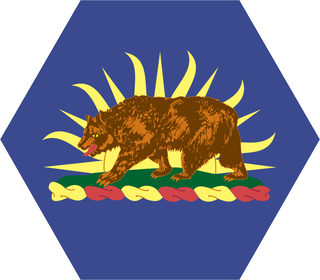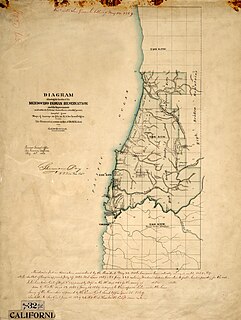
Mendocino County is a county located on the North Coast of the U.S. state of California. As of the 2010 census, the population was 87,841. The county seat is Ukiah.

George R. Crook was a career United States Army officer, most noted for his distinguished service during the American Civil War and the Indian Wars. During the 1880s, the Apache nicknamed Crook Nantan Lupan, which means "Chief Wolf."

The Pit River is a major river draining from northeastern California into the state's Central Valley. The Pit, the Klamath and the Columbia are the only three rivers in the U.S. that cross the Cascade Range.

The Yuki are an indigenous people of California, whose traditional territory is around Round Valley, Mendocino County. Today they are enrolled members of the Round Valley Indian Tribes of the Round Valley Reservation.
The Mariposa War was a conflict between Native Americans and miners in what was then the immense county of Mariposa in California.

The Mendocino War was the genocide of the Yuki between July 1859 to January 18, 1860 by white settlers in Mendocino County, California. It was caused by settler intrusion and slave raids on native lands and subsequent native retaliation, resulting in the deaths of hundreds of natives. In 1859, a band of locally sponsored rangers led by Walter S. Jarboe, called the Eel River Rangers, raided the countryside in an effort to remove natives from settler territory and move them onto the Nome Cult Farm, an area near the Mendocino Indian Reservation. By the time the Eel River Rangers were disbanded in 1860, Jarboe and his men had killed 283 warriors, captured 292, killed countless women and children, and only suffered 5 casualties themselves in just 23 engagements. The bill to the state for the rangers' services amounted to $11,143.43. Scholars, however, state that the damage to the area and natives in particular was even higher than reported, especially given the vast number of raiding parties formed outside of the Eel River Rangers. Frustrated with the inadequacy of federal protection, settlers formed their own raiding parties against the natives, joining Jarboe in his mission to rid Round Valley of its native population. Those that survived were moved to the Nome Cult Farm, where they experienced hardships typical of the reservation system of the day. After the conflict, contemporaries claimed that the conflict was more of a slaughter than a war, and later historians have labeled it a genocide.

California's involvement in the American Civil War included sending gold east to support the war effort, recruiting volunteer combat units to replace regular U.S. Army units sent east, in the area west of the Rocky Mountains, maintaining and building numerous camps and fortifications, suppressing secessionist activity and securing the New Mexico Territory against the Confederacy. The State of California did not send its units east, but many citizens traveled east and joined the Union Army there, some of whom became famous.

The Round Valley Indian Reservation is a federally recognized Indian reservation lying primarily in northern Mendocino County, California, United States. A small part of it extends northward into southern Trinity County. The total land area, including off-reservation trust land, is 93.939 km². More than two-thirds of this area is off-reservation trust land, including about 405 acres (1.64 km2) in the community of Covelo. The total resident population as of the 2000 census was 300 persons, of whom 99 lived in Covelo.

The Battle of Powder River, also known as the Reynolds Battle, occurred on March 17, 1876, in Montana Territory, United States. The attack on a Cheyenne Indian encampment by Colonel Joseph J. Reynolds initiated the Great Sioux War of 1876. Although destroying a large amount of Indian property, the attack was poorly carried out and probably solidified Lakota Sioux and northern Cheyenne resistance to the U.S. attempt to force them to sell the Black Hills and live on a reservation.

The California Army National Guard is the land force component of the California National Guard, one of the reserve components of the United States Army and is part of the National Guard of the United States. The California Army National Guard is composed of 18,450 soldiers. Nationwide, the Army National Guard comprises approximately one half of the US Army's available combat forces and approximately one third of its support organization. National coordination of various state National Guard units are maintained through the National Guard Bureau.
The Pit River Tribe is a federally recognized tribe of eleven bands of indigenous peoples of California. They primarily live along the Pit River in the northeast corner of California. Their name also is spelled as "Pitt River" in some historical records.

Visalia, California, commonly known in the 1850s as Four Creeks, is the oldest continuously inhabited inland European settlement between Stockton and Los Angeles. The city played an important role in the American colonization of the San Joaquin Valley as the county seat of Old Tulare County, an expansive region comprising most if not all of modern-day Fresno, Kings, and Kern counties.
The District of California was a Union Army command department formed during the American Civil War. The district was part of the Department of the Pacific, the commander of the department also being District commander. The district was created as a separate command on July 1, 1864, after Irvin McDowell took command of the Department of the Pacific, relieving General Wright, who then remained as District of California commander. The District comprised the state of California and the areas of the Rogue River and Umpqua River in Southern Oregon. Its headquarters were in San Francisco, co-located with those of the Department of the Pacific. On March 14, 1865, the District of Oregon was extended to include the entire state of Oregon, removing the Rogue River and Umpqua River areas from the District.

Bald Hills War (1858–1864) was a war fought by the forces of the California Militia, California Volunteers and soldiers of the U. S. Army against the Chilula, Lassik, Hupa, Mattole, Nongatl, Sinkyone, Tsnungwe, Wailaki, Whilkut and Wiyot Native American peoples.
Isaac Green Messec, sometimes Messic or Messick (1823–1901) was a Texas Ranger, 49er, miner, businessman, California State Militia Captain, county sheriff, sergeant-at-arms of the California State Senate and rancher, a well-known figure in political and mining circles early in the history of the State of California.
William Chauncey Kibbe (1822–1904), California pioneer, third Adjutant General of California that oversaw the California Militia from its beginnings through most of the American Civil War.

Mendocino Indian Reservation, a former Indian reservation in Mendocino County, one of the early Indian reservations to be established in California by the Federal Government for the resettlement of California Indians. It was established in the spring of 1856, in the vicinity of modern Noyo. Its area was 25,000 acres and its boundary extended north from what is now Simpson Lane at 39°24′43″N123°48′30″W to Abalobadiah Creek and east from the Pacific Ocean to a north–south line passing through the summit of Bald Hill.
The California Indian Wars were a series of massacres, wars, and battles between the United States Army, and the Indigenous peoples of California. The wars lasted from 1850, immediately after Alta California, acquired during the Mexican–American War, became the state of California, to 1880 when the last minor military operation on the Colorado River ended the Calloway Affair of 1880.
The Round Valley Settler Massacres of 1856–1859 were a series of attacks committed by white settlers from the Eastern United States against the Yuki people of Round Valley, Mendocino County, California as they moved west.










